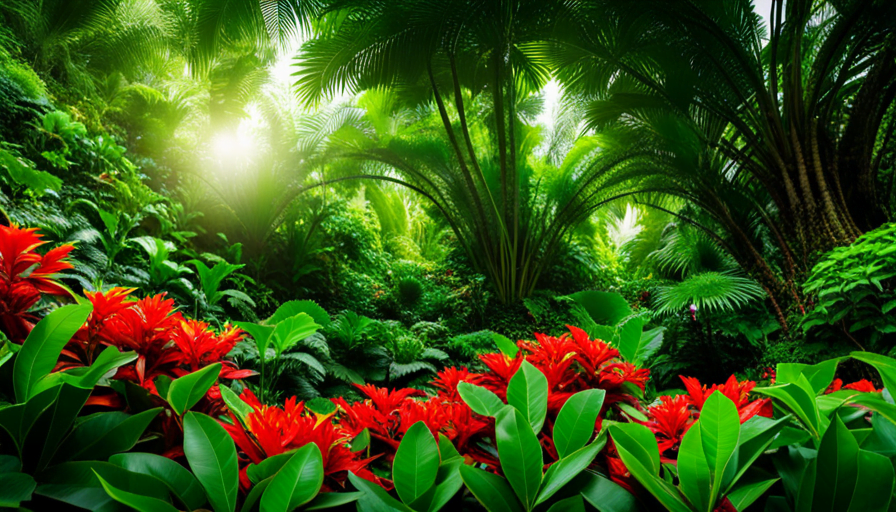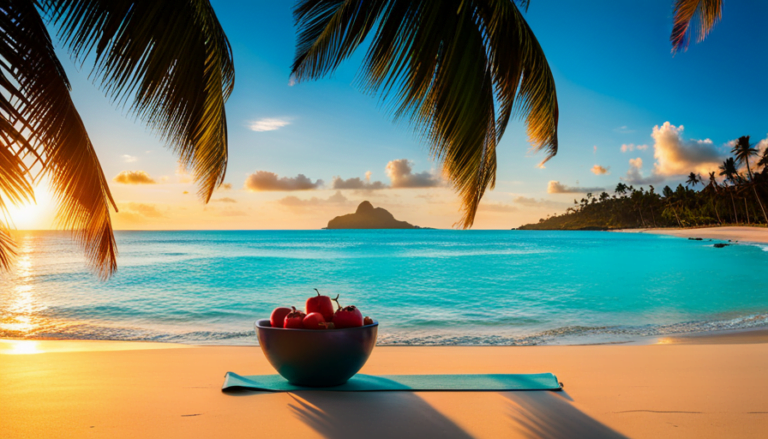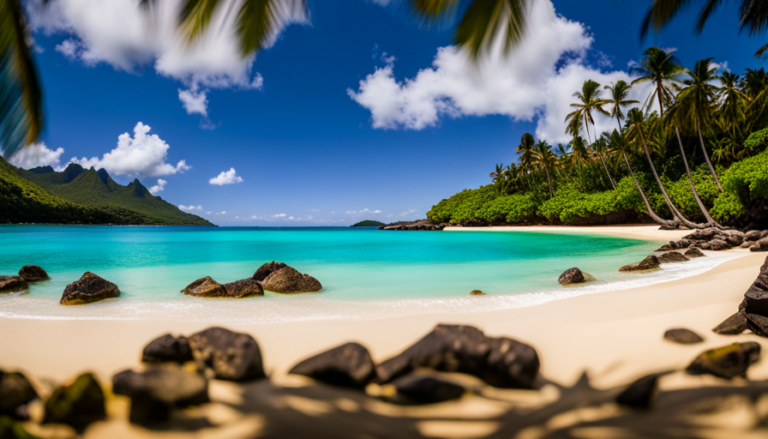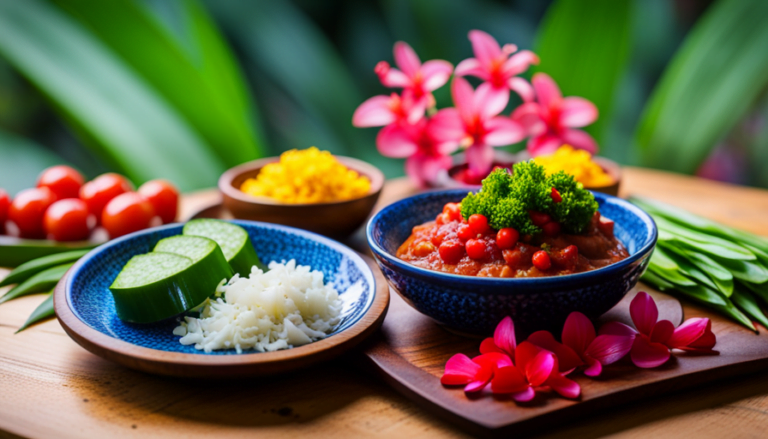“Dive Into Oahu’s Enchanting Rainforests 🌿: Biodiversity, Adventure, and Cultural Immersion”
Are you ready to embark on an adventure through the lush rainforests of Oahu? The island’s diverse flora and fauna make it a perfect destination for nature enthusiasts and eco-tourists alike.
From towering trees to shimmering waterfalls, Oahu’s rainforests offer a glimpse into the natural beauty of Hawaii.
As you explore the rainforests on foot, you’ll discover an abundance of plant life, including endemic species found nowhere else in the world. You’ll also have the chance to spot a variety of animals, such as birds, insects, and even the occasional wild pig.
But it’s not just about the sights and sounds; by immersing yourself in the culture of Hawaii and understanding the importance of biodiversity, you’ll gain a deeper appreciation for the delicate balance of these ecosystems.
So grab your hiking boots and get ready to experience the wonders of Oahu’s rainforests.
Key Takeaways
- Oahu’s rainforests offer a diverse array of unique and endemic flora and fauna that play a crucial role in maintaining biodiversity.
- Human impact and invasive species pose significant threats to the rainforests and their inhabitants, but ongoing conservation efforts and government policies aim to protect them.
- Responsible and sustainable tourism practices, such as staying on designated trails and avoiding littering, are crucial for preserving the rainforests for future generations.
- Immersing oneself in Hawaiian culture, including attending hula performances and participating in traditional activities like lei-making and surfing, can enhance the experience of exploring Oahu’s rainforests.
The Fascinating Diversity of Oahu’s Rainforests
You’ll be amazed by the sheer variety of plants and animals that call Oahu’s rainforests home! The rainforest ecology of Oahu is unique and diverse, with a wealth of endemic species found nowhere else in the world.
From towering trees to delicate ferns, the flora of the rainforest is awe-inspiring in its complexity and beauty. But the real magic of Oahu’s rainforests lies in its fauna. Endemic species conservation is a top priority in these forests, as many of the animals found here cannot be found anywhere else on earth.
From the vibrant Hawaiian honeycreeper to the elusive Oahu tree snail, there are countless species to discover and learn about. Exploring Oahu’s rainforests on foot is an experience like no other. As you trek through the lush undergrowth, you’ll encounter a world of wonder and amazement.
The sights, sounds, and smells of the rainforest will envelop you, transporting you to a place where the natural world reigns supreme. So, grab your hiking boots and get ready to embark on a journey of discovery and adventure in Oahu’s rainforests!
Exploring Oahu’s Rainforests on Foot
When trekking through the lush forests of this Hawaiian island, it’s important to keep your eyes peeled for hidden gems. The verdant rainforests of Oahu are home to a diverse range of flora and fauna that can only be fully appreciated on foot.
Here are three reasons why exploring Oahu’s rainforests on foot is a must-do activity:
Rainforest conservation: By walking through the rainforests, you’re supporting their conservation. Oahu’s rainforests are home to a number of endangered and endemic species that are protected by law. By participating in ecotourism activities, such as hiking, you’re helping to fund conservation efforts and protect these unique ecosystems.
Ecotourism benefits: In addition to supporting conservation efforts, ecotourism also provides economic benefits to local communities. By visiting and exploring the rainforests on foot, you’re supporting local businesses and providing jobs to those who live in the area. This helps to create a sustainable tourism industry that benefits both visitors and locals alike.
Unforgettable experiences: Finally, exploring Oahu’s rainforests on foot provides an unforgettable experience. From spotting rare birds to discovering hidden waterfalls, there’s always something new and exciting to discover. Walking through the rainforest at a leisurely pace also allows you to fully appreciate the beauty and tranquility of these unique ecosystems.
As you make your way through the rainforests of Oahu, keep an eye out for the next hidden gem on your journey. The rainforests are just the beginning of the natural wonders that await you on this beautiful island.
In the next section, we’ll discuss how to discover the waterfalls of Oahu’s rainforests.
Discovering the Waterfalls of Oahu’s Rainforests
Are you ready to discover the hidden gems of Oahu’s rainforest waterfalls? These beautiful natural wonders are waiting to be explored by adventurous travelers like you.
To make the most of your visit, be sure to plan your trip during the best times for waterfall viewing. Also, take necessary safety precautions to ensure a fun and safe adventure.
Hidden Gems to Explore
Discover some of the hidden gems waiting to be explored in Oahu’s rainforests! Offbeat trails and lesser-known waterfalls are just a few of the hidden gems that await you in the lush rainforests of Oahu. These trails are not as popular as the well-known ones, but they offer a unique and intimate experience with nature.
One of these hidden gems is the Manoa Falls Trail. Located in the Manoa Valley, this trail is a moderate hike that leads to a stunning waterfall. The trail is well-maintained, but it’s less crowded than other hikes in the area.
Another hidden gem is the Aiea Loop Trail, which is a 4.8-mile loop that offers stunning panoramic views of the island. The trail is not as well-known as some of the other hikes on the island, so you’ll be able to enjoy the serenity of nature without the crowds.
As you plan your trip to Oahu’s rainforests, it’s important to consider the best times to visit. The rainy season, which runs from November to March, can make the trails muddy and slippery. The summer months, from June to August, are the busiest and hottest times to visit. The best time to visit is during the spring or fall months when the weather is mild, and the crowds are smaller.
So, get ready to explore the hidden gems of Oahu’s rainforests and discover all the beauty that awaits you!
Best Times to Visit
It’s important to plan your trip to Oahu’s rainforests during the mild weather months of spring or fall to avoid the crowds and enjoy the beauty of nature. The best times to visit are from mid-March to May or from September to November. During these months, the weather patterns are more temperate, with fewer chances of heavy rainfall or extreme heat.
The spring and fall months are ideal for exploring the flora and fauna of Oahu’s rainforests. The lush greenery and blooming flowers make it a picturesque sight. Remember to pack comfortable clothing and shoes suitable for hiking.
Now that you know the best times to visit, let’s look at some important safety considerations.
Safety Considerations
As you journey through the lush wilderness of Oahu’s rainforests, keep in mind some important safety tips.
Rain gear and insect repellent are essential items for exploring Oahu’s rainforests safely. Oahu’s rainforests are known for their high rainfall, and while the rain makes for a beautiful and lush landscape, it can also lead to wet and slippery trails.
Wearing rain gear will help keep you dry and comfortable, and wearing insect repellent will protect you from the numerous insects that call the rainforest home.
Enjoying the rainforest without disturbing the delicate ecosystem is another important aspect of responsible tourism practices to keep in mind. Stick to designated trails and avoid stepping on plants and disturbing the natural habitat of the animals that live there. Remember that you’re a guest in their home and should treat it with respect.
Now that you’re prepared with the proper gear and knowledge of how to be a responsible tourist, it’s time to move on to the next exciting topic: wildlife watching in Oahu’s rainforests.
Wildlife Watching in Oahu’s Rainforests
You’ll spot a variety of unique creatures while exploring Oahu’s lush rainforests, from colorful birds flitting through the canopy to elusive native species hiding among the foliage. Wildlife photography is a popular activity for visitors, and guided tours are available for those who want a more in-depth experience. Keep in mind that while these animals may seem approachable, they’re still wild and should be observed from a safe distance.
One of the most iconic animals you may see in Oahu’s rainforests is the Hawaiian honeycreeper, also known as the ‘I’iwi bird. With its vibrant red and yellow feathers and curved beak, it’s a stunning sight to behold. Other bird species you may spot include the ‘Apapane, ‘Amakihi, and ‘Elepaio. Keep your eyes peeled for the endangered Oahu tree snail, which is only found in this region.
While exploring the rainforest, you may also come across feral pigs, which can be aggressive if they feel threatened. Other mammals such as the Hawaiian hoary bat and the Hawaiian monk seal are more elusive, but still call this area home.
Remember, it’s important to respect these creatures and their habitats to ensure their survival. Understanding the importance of biodiversity is key to preserving these delicate ecosystems.
Understanding the Importance of Biodiversity
You may be wondering why biodiversity is such a big deal, especially when it comes to Oahu’s rainforests.
Well, for starters, rainforests play a crucial role in maintaining biodiversity, as they’re home to a vast array of plant and animal species.
Unfortunately, Oahu’s rainforests are facing numerous threats to their biodiversity, including habitat loss, invasive species, and climate change.
However, there are ongoing conservation efforts aimed at protecting these precious ecosystems and the species that call them home.
The Role of Rainforests in Maintaining Biodiversity
When exploring Oahu’s rainforests, it’s like diving into a treasure trove of biodiversity. The lush green canopy and dense understory provide a vital habitat for countless species to thrive. Rainforests are known to be one of the most biologically diverse ecosystems on earth and play a crucial role in maintaining biodiversity.
Rainforests are home to thousands of plant and animal species, many of which are endemic to the region. They also provide numerous ecosystem services, such as regulating climate, filtering water, and preventing soil erosion. The impacts of deforestation have been severe in many parts of the world, including Oahu’s rainforests.
The loss of trees and other vegetation has resulted in the extinction of many species and the reduction of biodiversity. However, conservation efforts are being made to protect the remaining rainforests on Oahu. Efforts such as reforestation, habitat restoration, and sustainable forest management have been implemented to preserve the biodiversity of these rainforests.
Despite these efforts, there are still threats to biodiversity in Oahu’s rainforests that need to be addressed.
Threats to Biodiversity in Oahu’s Rainforests
As you venture deep into these dense forests, it’s hard to ignore the alarming threats to the diverse ecosystem that surrounds you. The human impact has been one of the major threats to the biodiversity of Oahu’s rainforests.
The native flora and fauna have been subjected to habitat destruction, fragmentation, and degradation due to human activities such as urbanization, agriculture, and logging. These activities have led to a loss of biodiversity, affecting the ecosystem services provided by the rainforests.
Aside from human impact, invasive species have also posed a significant threat to the biodiversity of Oahu’s rainforests. Invasive species such as the strawberry guava, Australian tree fern, and miconia have been introduced to the rainforests, displacing native species and altering the natural balance of the ecosystem.
Some invasive species also provide refuge for pests and diseases that further damage the native species. These threats to biodiversity highlight the need for conservation efforts to ensure the sustainability of the rainforests and the preservation of its diverse ecosystem.
Conservation Efforts
Now that you’re aware of the threats to biodiversity in Oahu’s rainforests, it’s important to know that there are ongoing conservation efforts in place.
Community involvement plays a huge role in preserving the flora and fauna of the rainforests. Local organizations and individuals have taken it upon themselves to educate the public about the importance of conservation and to take action towards protecting the environment.
In addition, the government has implemented policies to protect the rainforests and their inhabitants. The State of Hawaii has established protected areas, such as the Hauula Forest Reserve and the Waiawa Watershed, where people are not allowed to enter except for scientific research or educational purposes. The government has also implemented laws and regulations that prohibit damaging or removing any vegetation or wildlife from the rainforests.
These efforts have shown positive results in the recovery of endangered species and the restoration of damaged ecosystems.
As you continue to explore the flora and fauna of Oahu’s rainforests, it’s important to appreciate the conservation efforts that have been made by the community and the government. By respecting the environment and following guidelines, we can all contribute to the preservation of these unique and valuable ecosystems.
Now, let’s dive into immersing yourself in the culture of Hawaii.
Immersing Yourself in the Culture of Hawaii
Immerse yourself in Hawaiian culture by trying traditional dishes such as poi, kalua pig, and poke. Poi is a staple food made from taro root that’s been mashed and fermented. Kalua pig is a traditional dish that involves slow-cooking a whole pig in an underground oven called an imu. Poke is a raw fish salad that’s typically served as an appetizer. These dishes are not only delicious but also deeply rooted in Hawaiian culture.
Attending a hula performance is another way to immerse yourself in Hawaiian culture. Hula is a traditional dance that tells stories through movement and music. It’s a beautiful art form that has been passed down through generations. Watching a hula performance is a great way to appreciate the beauty and complexity of Hawaiian culture.
Here are some other ways to immerse yourself in Hawaiian culture:
Attend a lei-making workshop and learn how to make a traditional flower lei
Visit a traditional Hawaiian village and learn about the history and customs of the Hawaiian people
Take a surfing lesson and experience the sport that originated in Hawaii
Attend a Hawaiian language class and learn some basic phrases
By immersing yourself in Hawaiian culture, you’ll gain a deeper appreciation for the land and the people. This cultural immersion will prepare you for a successful rainforest adventure, where you’ll be able to fully appreciate the flora and fauna of Oahu’s rainforests.
Tips for a Successful Rainforest Adventure
When planning a rainforest adventure in Hawaii, there are a few things you need to keep in mind to ensure a successful trip.
Firstly, make sure you pack appropriately for the weather and terrain.
Secondly, consider the best times to visit, which tend to be during the drier months of May to September.
Lastly, practice responsible tourism by respecting the environment, avoiding littering, and staying on designated trails.
By following these tips, you can have an enjoyable and sustainable rainforest experience in Hawaii.
What to Pack
Don’t forget to pack insect repellent and a sturdy pair of hiking boots for exploring Oahu’s lush rainforests. These are essential items that will protect you from the mosquitoes and other insects that thrive in the humid environment.
In addition to these basics, here are some other items you should consider bringing with you on your rainforest adventure:
- A waterproof backpack to store your belongings and keep them dry
- A rain jacket or poncho to protect you from the frequent rain showers
- Sunscreen and a hat to protect you from the strong tropical sun
- A camera to capture the stunning beauty of the rainforest
- Plenty of water and snacks to keep you hydrated and energized throughout the day.
When it comes to clothing choices, it’s important to wear comfortable, breathable clothes that will keep you cool and dry. Lightweight, quick-drying fabrics are ideal, as they will dry quickly if you get caught in a rain shower.
Long pants and sleeves are recommended to protect you from the insects and underbrush, but make sure they are made of breathable materials to avoid feeling too hot and uncomfortable. With the right gear in tow, you’ll be ready to explore the wonders of Oahu’s rainforests.
As you prepare for your rainforest adventure, it’s important to also consider the best times to visit. These lush forests are beautiful year-round, but the weather can be unpredictable.
In the next section, we’ll discuss the best times to visit and what you can expect during each season.
Best Times to Visit
For optimal weather and fewer crowds, it’s best to plan your visit to the rainforest during the off-season. The rainforest experiences two main seasons: the wet season and the dry season. The wet season runs from November to March, and the dry season runs from April to October. During the wet season, rainfall can be heavy, leading to muddy trails and difficult hiking conditions. The dry season, on the other hand, sees less rain and more sunshine, making it the ideal time to explore the rainforest.
To give you a better idea of the weather patterns, take a look at the table below. It shows the average monthly rainfall and temperature in Oahu’s rainforest. As you can see, the wet season is characterized by high rainfall and cooler temperatures, while the dry season sees lower rainfall and warmer temperatures. Keep this in mind when planning your visit to the rainforest, as it can greatly impact your experience.
Now that you know the best times to visit the rainforest, it’s important to also consider responsible tourism practices. By being mindful of your impact on the environment and local community, you can help preserve this beautiful and diverse ecosystem for generations to come.
Responsible Tourism Practices
To ensure the preservation of this diverse ecosystem, it’s imperative that visitors practice responsible tourism. Sustainable tourism is the key to ensuring that the flora and fauna of Oahu’s rainforests remain intact for future generations to enjoy.
Here are some eco-friendly practices that visitors can adopt during their visit:
- Stick to designated trails and avoid trampling on vegetation.
- Refrain from feeding or touching wildlife as this can disrupt their natural behavior.
- Take only memories and leave only footprints. Properly dispose of any trash to avoid littering the rainforest.
By following these simple practices, visitors can minimize their impact on the rainforest and help preserve its delicate ecosystem.
Remember, responsible tourism isn’t just a buzzword, but a necessary action to protect our planet and its natural treasures.
Conclusion
Congratulations on exploring the flora and fauna of Oahu’s rainforests! You’ve embarked on a journey that’s allowed you to witness the wonders of nature and understand the importance of biodiversity.
Just like the rainforest, we’re a diverse community with different species, cultures, and beliefs. And just like the rainforest, we need to maintain our diversity to ensure our survival.
As you trek through the rainforest, you’ve witnessed the interconnectedness of all living beings. The plants provide shelter and food for the animals, while the animals help with pollination and seed dispersal. This intricate web of life is a reminder that we must work together to protect our planet and all its inhabitants.
Just as each species in the rainforest has a unique role to play, so do we in our society. We must embrace our differences and work towards a common goal of preserving our planet for future generations.
In conclusion, your rainforest adventure has been a valuable experience that’s allowed you to appreciate the beauty and complexity of nature. As you return to your everyday life, remember the lessons you’ve learned from the rainforest. Be mindful of your impact on the environment and strive to make a positive difference. Just like the rainforest, we must all work together to ensure a sustainable future for all.







